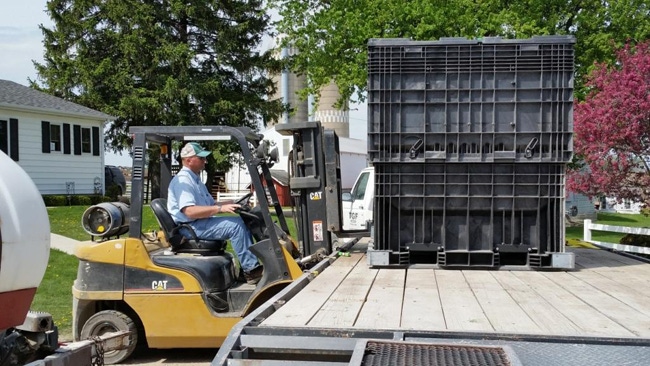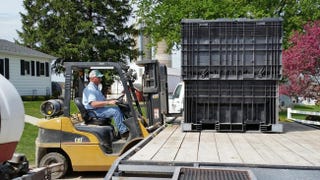June 6, 2014

After a winter that dragged on and on for what seemed like forever, we had a spring that also seemed to run way longer than a season should. All that snow (more than 60" this winter) was followed by no shortage of moisture this spring. No surplus of heat showed up with the rain, either. That meant planting was a lot later than usual.
This year, we managed to get the vast majority of our acreage planted in a reasonable time compared to last year. Handling of the actual seeds is a bit different these days than it was ten years ago. It's not a matter of lugging 50- or 60-pound bags of seed around and filling small boxes on each row of the planter with seed. Now the seed comes in bulk containers, either a plastic box that's about 45" wide by 57" long by 65" tall or in giant plastic-canvas bags that hold about the same amount without all the structure of a box. The jumbo bags usually arrive on a pallet and have loops on all four corners where you can take the tines of your pallet fork and put them through the loops and then lift the jumbo bag into position. A small rope is untied underneath and the small closure is unleashed so that the entire contents of the bag empty out in a matter of seconds.
Bulk seed bag
Think about that for a moment. Roughly 2500 pounds of seed shows up in a matter of ten or fifteen seconds. That's kind of like having an eight-inch-diameter nozzle on the end of the ketchup spigot at McDonald's. It's almost nuts.
An eight-inch-nozzle on the Blizzard machine at Dairy Queen? That's engineering brilliance. I'd include actual scoop shovels instead of dinky spoons in the toppings bins, too, but that's just me.
So instead of dumping 2500 pounds of seed all at once into a single planter box, or cleaning up the mess from putting it on the ground and transferring it to the machine, our industry invented bulk seed handling devices. We got one of these a few years ago.
It's pretty slick.
It also tends to change things from seed handling being a multi-person event to more of a one-man operation. I take a seed box and load it into the Seed Runner by myself in a matter of maybe a minute or two from start to finish. Then I take it to the field and Guy No. 1 can either fill the planter while I'm there, or he can do it on his own later. Either way, we aren't man-handling 12, 24 or 36 individual bags of seed once from the pallet to the truck, then again from the truck to the planter. We're also not dealing with all of those empty seed bags that have to be anchored down when the wind gets to be more than 3 miles per hour.
Another option for bulk bags would be one of these things. Think of it as building a better mouse trap, or a better eight-inch ketchup nozzle.
Nearly all of our bulk seed gets delivered by the dealer. They show up with either an enclosed semi trailer or a pickup and flatbed with boxes of seed on it. I then take the skid loader and transfer those boxes to a storage shed until it's time to use them. Not a lot of heavy lifting involved. Coincidentally, if you look at a progression of pictures of this columnist over the years, you will notice I'm not getting smaller.
At the end of the planting season, things get interesting. Sometimes the dealers will stop by and pick up the empty seed boxes. As handy as they would be as storage containers, they come with a tab of about $800 each if they aren't returned to be reused the next season.
Handy has a price. It's way less than eight c-notes. The boxes don't stick around. They get returned.

Self-serve
The spread-out planting season meant a spread-out season of use for seed boxes this year. We had some later-maturing varieties we wanted to switch for earlier numbers. As dedicated a guy as he is, one of my seed suppliers couldn't get the swap done for me with delivery included. If I wanted to bring the boxes back with my own pickup and trailer, he'd get me switched over.
It didn't take much to talk me into strapping some cargo down on the flatbed and hitting the road. Once I got to my destination, I did not find my master seedsman around. Instead, I found his teenage daughter. We talked about hybrid variety numbers -- what I had with me and what I needed. It wasn't going completely over her head, but I could see the confidence leaving her face . . . like there was one of those eight-inch ketchup nozzles to get it done quicker.
She decided she'd call her dad and see what he thought. I suggested maybe I'd call him and spare her the middleman translation work. It took all of three decimal places of a second to get her on board with that idea.
Numbers were discussed with the seed salesman. He had what I needed and he'd probably be done with his task at hand and back to the warehouse in about an hour to get my needs handled.
I was in the warehouse at the moment and mentioned that, in fact, he did have the exact numbers that I wanted, because I happened to be standing right in front of those boxes at the moment.
"Oh, you're there?" came the surprised reply from the seedsman.
This isn't the first season this guy has been doing this seed stuff. When customers show up to switch one variety for another, they're usually a matter of minutes away from putting the new variety into the planter. Kicking back and relaxing for an hour and change doesn't happen.
"Weeeelllll . . ." said the seed guy.
This wasn't a really long, awkward pause, but I knew there was a lot of advanced mathematics and scenario equations going through his mind at the moment. I could hear the gears turning in his head over the phone. He was probably thinking about all of the potential problems in front of him. An unhappy customer and an unfinished task for himself were at opposite ends of his mental teeter totter. Keep the customer happy, but don't get your own work done. Finish the work, but get the customer steamed.
In a matter of seconds, he reached a conclusion to the story problem in front of him. I could sense the change in tone of his voice.
"Aww, you can get 'em. Just take the forklift and run it yourself. You can do it. I don't let anybody else run it, but I trust you."
I agreed to it.
Maybe it was the time stress, but I went along with his decision without hesitating.
Why was it so easy? Turns out I'd been to the other seed dealer's place a day or two before and didn't find anyone around. All I had was an empty box to return while I was in the area for another task, so why go back home with it? They're too big (and costly) to simply push out the back end of the truck and drop on the ground, so I figured I'd jump on his forklift and get it out myself. Never mind the fact that I'd never run a forklift before. Inexperience and cluelessness are lame excuses.
Besides, this wasn't exactly me at the helm of the Nina, the Pinta and the Santa Maria here, ready to head out and see if there actually was an edge on the earth. This wasn't brain surgery, either. Brain surgery's not that tough. They let University of Iowa grads do it.
This was a fairly simple task done on a regular basis by lots of people, none of whom have ever been me. They made it look easy. Plus, there would sometimes be a trail of seed to make it look not-quite-foolproof, so I knew I wouldn't be establishing any records for the Guinness people if I screwed up.
I jumped on that forklift (a Toyota) and got the box unloaded with no problem. In fact, I kind of liked how the thing worked. I should probably have one of these forklifts myself, I thought. Me, an engine and mobile leverage. What could possibly go wrong?
My task at the moment at the current seed guy's place was different, though. This wasn't an empty seed box return project. This was several empty boxes to be unloaded and then a couple of full ones to be re-loaded. Worst-case scenario, dumping an empty box and crushing it to smithereens would be $800. A full box of seed could be twelve to twenty thousand bucks.
The empties were not that big a deal to unload. The full ones weren't bad, either. I was pretty much a veteran forklift operator by then. Another customer drove into the yard about that time. He started talking to the seedsman's daughter while I was on the forklift, looking like I knew what I was doing.
When I was done with my loading and had all of my cargo strapped down securely (I learn a few things from these stories myself once in a while!), I walked over to see what the two of them were doing. They had a variety number they were searching for so that the customer could get it and get back to work.
Small problem. They weren't finding the number in the stacks and stacks of varieties in the warehouse.
Potentially larger problem. The number they wanted was the same one I had just loaded on my own trailer. I was beginning to wonder if I'd just swiped that last of what would have finished this guy's planting season and made his year.
(With frosting smeared all over my face like a three-year-old.) "Cake? Nope, no cake here. Haven't seen cake for a long time."
I chose to keep my trailer's math inventory to myself at the moment. Let's maybe try a question to potentially get me off the hook.
So, how much did you need?
(Please don't say three boxes! Please don't say three boxes!)
"Fifteen bags," said the customer.
Whew! Bags. Little bags. The ones you have to lift by hand. I'm in the clear, kind of.
At that moment, perhaps I was looking toward the heavens as a winking thank you, but I happened to spot a partial pallet of bags with the very variety we needed. And it was only on the fourth partial pallet from the bottom, just a foot or two over my head!
Not a chance this guy's going to say, "Here, let me reach up there seven or eight feet and grab all of these while you two wait by the truck."
Nope, this was forklift time again. Clearly, of the three of us, I was the veteran forkie, and I was pretty sure this guy wasn't going to wait for the professional seedsman to return.
I looked at the young lady and said, "Okay, I'll get 'em loaded then."
She smiled at my confidence and managed not to laugh . . . at my abilities.
The acquisition and loading process went quite well. Once I was finished, the other customer looked at me, obviously now knowing who I was (and that was mutual), and asked, "You work here now?"
Nah, I'm just a customer.
"WHAT?!? Really? I don't think I know you," he said with more than a little surprise in his voice.
So I offered up my name, quickly followed by my parents' names.
That bought me instant credibility. (We're talking the last part of my identity, not the first.) Turns out he sees my folks in town at coffee on a regular basis.
I was just glad he wasn't going to identify me to them the next time as "that idiot who put a big dent in my tailgate!"
His truck looked just as sharp when he left as when he got there. Only rookie forklift operators bang stuff up.
When I brought my empty seed boxes back a couple days later, Sherill was along with me. She gets the photo credit for one of these images. We got out of the truck and the seedsman looked at me and said, "I've got some stuff to do. You might as well get 'em yourself. You know what you're doing."
Nope, not even close, not for most of my life, but why burst his bubble now?
Jeff Ryan is Guy No. 2 in the operation of Two Guys Farming, Inc., near Cresco, IA.
Like our blogs? Subscribe to Farm Industry News Now e-newsletter to get the latest from our bloggers and more straight to your inbox twice weekly.
About the Author(s)
You May Also Like






